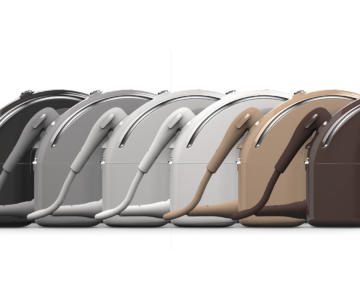By Rebecca Cale, Regional Clinical Training Manager at Cochlear Americas
Cristofari, E., Cuda, D., Martini, A., Forli, F., Zanetti, D., Di Lisi, D., Marsella, P., Marchioni, D., Vincenti, V., Aimoni, C., Paludetti, G., Barezzani, M., Leone, C., Quaranta, N., Bianchedi, M., Presutti, L., Volpe, A., Redaelli de Zinis, L., Cantore, I., …Malerba, P.
A Multicenter Clinical Evaluation of Data Logging in Cochlear Implant Recipients Using Automated Scene Classification Technologies
Dec 13, 2017:226-235
Audiology and Neurotology Journal
In today’s busy clinical environment, clinicians who value research-based practice often struggle to keep up with current literature. To help, we’re excited to offer a Cochlear ProNews monthly feature – Journal Club! Each month, rotating guest authors will present a current journal article summary.
This month’s Journal Club explores a 2017 study, A Multicenter Clinical Evaluation of Data Logging in Cochlear Implant Recipients Using Automated Scene Classification Technologies.
What did the study investigate?
The aim of this study was to investigate recipients’ daily use of cochlear implants with an objective measure tool that looks at real-time recordings of various listening environments and device usage. A secondary goal was to assess whether this information can be used to help support counseling and management of device settings.
Why is this important?
Data logging is designed to assist clinicians with compliance, counselling, troubleshooting and programming their recipients’ device. Data logging is a feature that was first introduced in the Cochlear™ Nucleus® 6 System and is currently available in the Cochlear™ Nucleus® 7 Processor and Cochlear™ Kanso Processor. It provides clinicians with valuable, evidence-based feedback about a patient’s listening environment and device usage. Accurate insights may help clinicians troubleshoot faster, deliver more effective counselling and save valuable clinical time in the long term.1
How did they do it?
The study was a multi-center prospective investigation that analyzed Custom Sound files for 1366 Cochlear Nucleus 6 recipients. The recipients were required to have at least six months of device use experience. Patient data was analyzed with a tool that allowed for the investigation of the Custom Sound files.
The following categories were assessed for each patient:
- Gender
- Age
- Listening environments (music, wind, speech in noise, speech in quiet, quiet and noise)
- Loudness levels
- Daily average use
Results1
Gender and age
The study included 693 females and 673 males. The age groups were classified into 11 different cohorts and can be shown in Table 1 below. The distribution of gender and age (adult vs. child) was equal throughout the study.

Daily average use
The amount of time the recipients used their device was classified as the daily average use. Results from this study show that the average daily use was 13 hours per day, with the lowest amount of time being the age group 5 and younger (9 to 10 hours per day), and the highest amount of use being the age group of 6 to 18 years (13.3 hours per day).
Cristofari speculated that the low use for the age group 5 and younger was because the significant increase in the amount of time spent asleep each day in younger children (14.2 hours at 6 months of age). The authors also further determined that the low use time may be due to the lack of cooperation in younger children and the inability for this age group to inform caregivers about a malfunction of the device (coil falling off the implant site, etc.).
Involvement in extra curricular activities and school was thought to be the reason that the highest amount of use was found in the age group 6 to 18 years. In addition, these recipients are heavily dependent on their cochlear implants because they were implanted at such a young age.

Music
Further, here are the results regarding music:
- Age 3 to 5 spent on average 118 minutes per day
- Age 6 to 10 spent on average 103 minutes per day
- Age 14 to 18 spent on average 45 minutes per day
- Age 19 to over 75 spent on average 22 minutes per day
Cristofari contributed the increase in time spent in the music group for the youngest age group due to speech therapy sessions and television programs that incorporate more music than those watched in older age groups.
Speech in noise
Recipients in all age groups spent on average 219 minutes per day in speech in noise, with the greatest amount of time in the 6 to 18 years of age. The greatest exposure was for the 11 to 13-year-olds, logging 306 minutes per day on average.
The research suggests that this is a result of the 6- to 18-year-olds spending a large portion of their day in noisy school environments. These findings demonstrate the importance of ensuring the acoustics of classrooms follow the American National Standard Institute, 2010 guidelines for low sound-to-noise level ratio (SNR) levels and reverberation times.
Speech in quiet
The recipients that spent the most amount of time in speech in quiet were age 6 to 10 years old with 104 minutes per day on average. The age group that spent the lowest amount of time in speech in quiet were age 19 to 30 years at 47.5 minutes per day.
Quiet
The amount of time spent in quiet increased with age, with recipients over 75 years spending the most amount of time (on average of 305 minutes per day) and children age 3 to 5 years of age spending the least amount of time (average of 111 minutes per day).
Noise
For this condition, the individuals that spent the most amount of time were in the 19 to 65 year age group, with an average of 123 minutes per day. Children age 0 to 2 years of age only spent 42 minutes per day in noise.
Wind

The amount of time spent in wind was very low for all age groups. Children age 0 to 2 spent the most amount of time with an average of 0.183 minutes per day.
Loudness ranges
For all age groups, on average, the majority of time is spent between the 50 and 69 dB SPL. The authors noted the importance of this finding since this is the typical level of speech.

Conclusion
Data logging is a tool that assists the clinician with the ability to make informed decisions regarding their recipients’ device use and environment in everyday situations. The information obtained from data logging can help with counseling, troubleshooting and maybe even programming their recipients. Cristofari states that this tool can help eliminate the chance that an “intrinsic bias represented by under or overestimation and inaccurate responses exists.” It also allows centers to compare results from multiple patients over time.
This research provides important information regarding the differences between children and adult cochlear implant users which can be used in counseling and recommendation of specific hearing strategies (for example, background noise reduction or wireless accessories).
Information obtained from the daily average use of the device can be useful when looking at possible causes of negative outcomes. A lack of use should be considered with poorer outcomes and the recipients should be encouraged to increase their overall use time.
Learn more by accessing the publication and stay tuned for next month’s edition of Journal Club!
About the author: Rebecca Cale is a Regional Clinical Technical Manager for Cochlear Americas. Rebecca joined Cochlear in March of 2012. In her current role, Rebecca is responsible for providing education and training to professionals working with implantable solutions, along with assisting in the clinical care of Cochlear Implant and Baha recipients. Rebecca received her Doctorate of Audiology from East Tennessee State University (ETSU). She currently resides in Reno, Nevada.
References
- Cristofari, E., Cuda, D., Martini, A., Forli, F., Zanetti, D., Di Lisi, D., … Malerba, P. (2017). A Multicenter Clinical Evaluation of Data Logging in Cochlear Implant Recipients Using Automated Scene Classification Technologies. Audiology and Neurotology, 226-235. https://doi.org/10.1159/000484078
SNR-NR, WNR and SCAN are approved for use with any recipient ages 6 years and older who is able to 1) complete objective speech perception testing in quiet and in noise in order to determine and document performance 2) report a preference for different program settings.




